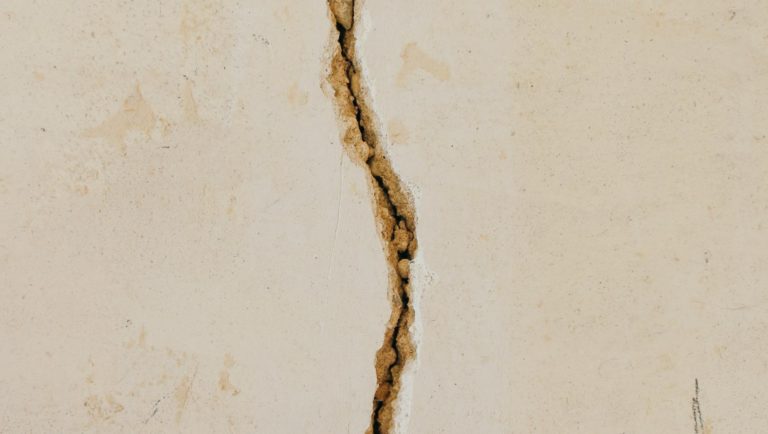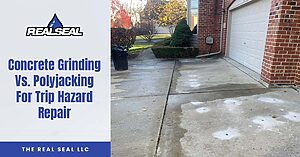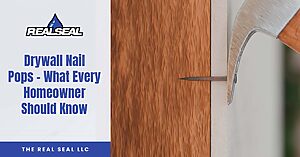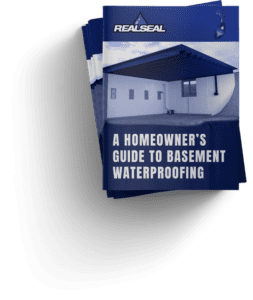This discussion has been around for as long as both products have existed. Like most disagreements, you’ll find the manufacturers on separate sides of the aisle, along with their distributors and end-users. “My product is better” “No, MY product is better.” Anyone get any flashbacks from childhood?
Difference In Epoxy and Polyurethane in Concrete Crack Injections
When it comes to injecting Foundation Cracks, the industry generally uses two products, but there are a couple extra out there as well:
Non-expanding Epoxy Resin
The strongest repair available. Non-Expanding Epoxy bonds best with concrete. This resin will stand the test of time and will not be worn away by water or the elements. The only downside to using Epoxy is that you need a skilled, trained technician to install. This material does not come in the “do it yourself” kits sold at box stores. Again, proper training is required to install correctly, but this is by far the strongest material to inject into a Concrete Crack.
Expanding Polyurethane Foam
While Epoxy is the strongest material used on Concrete Cracks, Polyurethane is the most common. This is due to one overwhelming reason: it is extremely easy to install. So easy, in fact, that kits of it are sold at any box stores and even online. Handy homeowners can purchase the kits and give it a go. Problem with this is that Polyurethane has the highest “Call back” rate in the industry. The material breaks down, and as a skilled technician is not needed for the injection, many times one is not used. Companies can hire and “train” these technicians quickly, with their purpose being to install as much product as possible, neglecting quality. In some cases, Polyurethane is used, like around Sewer Pipes or in large, shifting cracks. Otherwise, Epoxy is best.
Bentonite
Bentonite is an expanding clay that is used on the outside of foundation walls to waterproof them. A foundation can be dug out and this dry powder laid all around. Once the powder comes into contact with water, it expands and seals. The problem with this is the repair is not instant (it may take a few rains to completely seal) and the clay product can come in through the cracks in the wall, so definitely not recommended with a finished basement. Used mostly by construction companies decades ago, we now have moved to more reliable and instant forms of repair, including Epoxy and Polyurethane.
Hydraulic Cement
This one is merely included to show the “band-aid” patch that is done. Never is Hydraulic Cement anything more than a surface patch for a Foundation Crack Repair. While it will stop water on a temporary basis, this is not a permanent solution. It cannot be done on a Foundation Crack when selling a home and be considered a “professional repair.” Whenever we see this, we see it for what it is, an attempt to stop the water temporarily and save $.
Learn more – Hydraulic Cement: Uses and Applications
Drilling Holes
Very often, we come across Concrete Crack Repairs that have metal injection ports on them. An old-time way of repairing cracks was to literally drill into them and inject an expanding Polyurethane. A technician would drill a hole next to the crack into the foundation, angled toward the crack. The idea being that the port crosses the crack in the wall. Then, the tech will inject the foam.
Problem with this is there is no way to ensure the whole crack is filled. It is a “spray and pray” method. The second problem is that if that repair does not hold, you cannot inject from the inside anymore, it MUST be repaired from the outside.
There are still a couple companies out there that do this old-fashioned method. Why? Because it is what they have always known. And how many times do we continue doing what we have known just for the sake that we know it?
How Foundation Crack Injection Works
Here’s a step-by-step process on how foundation crack injection works.
- First, your crack is covered using an epoxy bonding solution. This prepares your crack for the injection.
- Next, your crack is injected using a 2-part epoxy solution that completely fills the void, waterproofing and reinforcing your wall.
- That’s it. Simple as that.
Summing Up
Just like any industry that uses technology, over time the technology gets better. As part of the industry, it is our responsibility to use the best techniques and materials.
- Non-Expanding Epoxy Resin is the best product to use for your Concrete Crack Repairs.
- Polyurethane expanding foam can be used in certain situations but is by no means a default product.
- Bentonite can work as well, but is sloppy and can take a few rains to be effective.
- Hydraulic Cement is a band-aid.
- Drilling Holes is to be avoided at all costs.
“Not Everything’s Better When Wet”







37 Responses
Read your article with interest.
I would appreciate a minute of your time.
A worker filled a crack (not more than 1/2″ wide with “something”.
It evidently was an expanding crack filler. It is greenish yellow.
I have tried to remove the overflow with numerous items. He grinded the crack smooth.
Not even muriatic acid will remove it.
Do you think it is polyurethane?
I need to know, before I try to paint over it.
Many thanks.
Hi William!
Happy to help. From what you are describing, it seems they injected the crack with a polyurethane. You should be able to remove it with a drywall knife and smooth it down with sand paper. It is possible they used a hybrid chemical as well that is harder to remove. They shouldn’t have left that overflow and should have cleaned it up prior to leaving the job site. It doesn’t hurt anything, it’s just ugly. You can also try a paint scraper to get it off.
Hi Austin,
I recently found leaks in my basement. The leak is through the horizontal joint between the concrete stairs, whose shoe is sitting on a concrete foundation wall. The joint might have expanded over time due to different settling along the foundation wall. After any rain, water leaks through this joint, as it is along the nosing of the first step of the stairs; so all water from upper steps runs over this nosing, which now leaks. Although the joint between the concrete stairs shoe and foundation wall is not structural, it is horizontal. What is the recommended solution to stop the leak? Epoxy resin or polyurethane injection? If so, would you inject from inside (in the basement) or outside between the stair riser and tread (through the nosing)? I very much appreciate your time.
Hi Sean,
If I had a guess, I’d say that there is a door at the top of the stairs going outside as well, correct? The best solution for a horizontal seam at the top of the foundation by the stairs would be Exterior Sealing. The door itself and frame may need flashing repairs or caulking. Outside, if there is a stoop, it may need to be removed to apply an elastomeric tar seal to the outside of the foundation, and then re-built.
If you are able to see the crack/joint in the foundation, it is possible to inject with epoxy, but I’m worried the water may be coming more from above and it would just push the water to another area.
\ | I am illustrating the side view of the leak in the drawing
\ | on the left, where it is indicated by x.
\ ——–
\ |
\ |
\ ———-
\ concrete stairs |
\ |
-X–X–X–X–X–
—————– ———–
basement | concrete || concrete |
| foundation || step |
| wall | ——— sidewalk ————————–
| |
| |
Yes, great drawing with what you have available, Sean! I do think the exterior sealing would be the best solution, as well as addressing any sealing/flashing issues with the door there.
|||||||||||||||
|||||||||||||||
bb |||||||||||||||||||||||||
bb |||||||||||||||||||||||||
bbbbbbbbb |||||||||||||||||||||||||||
bbbbbbbbb |||||||||||||||||||||||||||
bbbbbbbbbbbb LLLLLLLLLLLLL
bbbbbbbbbbbb wwwwwww |||||||||||||||||
bbbbbbbbbbbb wwwwwww |||||||||||||||||
bbbbbbbbbbbb wwwwwww oooooooooooooooooooooooooooooooo
bbbbbbbbbbbb wwwwwww
bbbbbbbbbbbb wwwwwww
bbbbbbbbbbbb wwwwwww
bbbbbbbbbbbb wwwwwww
bbbbbbbbbbbb wwwwwww
Thanks Austin. Yes, there is an exterior door on the highest step, but the leak is through the nosing of the lowest step. I tried to illustrate the side view again above. Hope this time my drawing works.
In my drawing,
L is the leaky line above the foundation wall.
w indicates the foundation wall.
b stands for basement area under the stairs.
o means outside, where the concrete side walk is located.
Thank you, Sean. Yes, this seal will be best done from the exterior. The steps may need to be removed to get to the foundation top, and the door may need to be resealed.
Thanks, will epoxy be a lifetime solution, as the foundation may settle further, or summer/winter temperature variation may open the gap again?
Hello Sean!
If your foundation is settling, no epoxy or polyurethane will last forever. The foundation settlement must be handled first and foremost. It is often misrepresented in the industry that is okay for a foundation wall to be constantly moving. It is not. If a crack continues to re-open and leak after repair, this means there is some foundation movement that needs to be handled first.
If the foundation is no longer settling, the epoxy is a lifetime warrantied solution. If it were to ever leak, the company should come back out to repair at no charge.
Thanks, my other question is what epoxy brand do you recommend, since there are many brands out there? Also, I’ve seen epoxy resins coming in one bottle, which does not mix with anything else, as opposed to those you talked in your videos, which come in two bottles, 2 to 1 ratio mixture? Really appreciate your time.
Hello Sean!
We recommend you go with a contractor that will provide a warranty. There are many epoxy brands out there, and the big box store epoxy is not the top-of-the-line epoxy you want to use. We prefer a 2-part Straight Epoxy mix for most of our foundation crack repairs. Polyurethane can be used, but only in certain situations where Epoxy would not be practical (like pipe penetrations or cracks larger than 1/2″ wide.
Hello-My poured concrete foundation has hairline cracks, and I received estimates to repair them. Before I proceed, I wanted to get your opinion. Is it ok to use BOTH epoxy and poly as outlined below? I’m confused as I thought one or the other should be used not both.
1.Drill a series of 1⁄2 holes bisecting crack along poured foundation wall.
2.Install an injection port in each hole.
3.Surface seal around each port and the crack using epoxy.
4.Inject expandable polyurethane resin into each port to fill and seal crack.
Hello Monica!
Thanks for the question. For the majority of cracks, you want to use epoxy. The only situations we use urethane to inject foundation cracks are for filling large gaps. The two most common scenarios are when a foundation crack is over 1/2″ wide as well as if pockets are found while injecting. Once the void is filled, epoxy is switched back and used, as it is the stronger solution.
Also drilling ports is no longer necessary. While it may be necessary to chip away some of a previous patch to find the crack, we find that the drilling method does not fill the crack all the way and if it needs to be re-repaired, you’ll have to pay for a more expensive exterior fix.
Is epoxy ok to use in wet cracks ?
Hi Francis!
Yes, Epoxy can be used in wet cracks. Many times, cracks are actively leaking while we fix them, and the epoxy is designed to work in such situations.
My question is 20yrs ago I had foundation cracks fixed with Epoxy injections recently one crack started leaking again covered under warranty repaired but this fix they could not get the Epoxy into crack so they surfaced fixed. Your thoughts thanks
Hi Raymond!
Sounds like they just did a patch-job and didn’t fix the leak. If they couldn’t get Epoxy into the crack, it is standard procedure to then dig the crack from the outside and repair.
Monitor that crack, it’s going to leak again with just that surface patch repaired.
I built my house two years and a month ago. The plumber drilled through my 10″ thick concrete wall and connected the main water supply line through that hole. Then he filled in around the pipe in the hole around the pipe (between the pipe and concrete wall) with hydraulic cement. Recently I read that hydraulic cement only lasts for 2 years. So I went and looked, and it has turned white in places and has a slow weaping leak. What is the best way to fix this?
Right now I could dig down from the outside and get to it from the exterior side of the wall. In a couple of weeks, I’m on schedule to pour concrete over that area. From some research it seems it can be repaired from the inside. There isn’t much information on repairing it from the outside.
In addition, the furnace will have to be detached and moved out of the way to get to the leaking area on the inside. So how should this be handled?
Hi Scott!
That’s a good question. Typically, when we repair pipe penetrations (sewer, water, electric, gas), we like to do them from the inside. The repair is more efficient and cost-effective, and comes with a Lifetime Warranty. Usually this repair is under $500. It is performed via Epoxy Polyurethane Injection to fill the entire void inside the wall between the pipe and the wall.
However, in your case, you have a furnace in the way. So it may be cheaper and easier for you to dig it down to the pipe due to the cost of the furnace removal and replacement. In this case, you’ll dig down to the pipe, clean all around the pipe, and then re-apply Hydraulic Cement as well as an elastomeric waterproofing tar. A vapor barrier will be applied to protect the tar during the backfill process (which is done immediately, no wait time), and the pipe is sealed!
Both ways work and will come with a Lifetime Warranty from a local contractor that does the work. Where are you located? We are in Chicagoland, but may have a referral for you if you are in another part of the country.
Thank you for the response. I’m in West Georgia area around Carrollton, GA. I’m going to try to repair it myself.
My backyard slopes down and the pool is built on concrete columns reinforced with rebar.
Two concrete columns holding up
My pool have cracks and spalling. One crack is a through crack. The pool has shifted and leaks a bit and three or four tiles in that corner have cracked.
Can these columns be repaired or reinforced, or do they need to be removed and the whole pool replaced.
Hi Judy!
Thanks for reaching out. So columns can be reinforced and/or replaced, I know that for sure. What I do not know is how that will affect the pool above and weather or not the pool will need to be replaced. I would get the company who build the pool, or a reputable pool repair company, out to take a look and see what they recommend.
We were resently forced to install a new water line into the house, through a pour concrete wall. The protrusion was made through a wall with a covered porch, so digging down was not feasible. The is bentonite stuffed in the hole, past the concrete. A contractor recommends allowing bentonite into the concrete, and finishing with hydrocement. Do you recommend this or epoxy, and why?
Hi Larry!
We recommend injecting a polyurethane foam around the line from the inside. The bentonite may work, but we’ve seen that leak before as well. The expanding foam will fill all the nooks and also allow for small movement in the pipe without breaking the seal.
Any recommendation for a contractor in the St. Louis MO area? Thanks!
Hi Terry!
Unfortunately we do not have anyone down in the St. Louis area.
My brother purchased a earth contact home (dirt on the top of the house) a couple of years ago. The dirt is on top of 4 concrete domes. Previous owner said, no leaks (I don’t believe him). So this year after a long drought, a leak appears in the house. It looks like, since we can’t really see the concrete and where the leak is, it might be coming from where two domes come together. Same area is a bathroom fan flue that exits the roof. The only way to actually see the crack/leak is to dig the dirt off the roof area. Is there an easier way to fix this? Would injecting epoxy into the area be a fix? Or would bentonite be a better fix? I am familiar with bentonite as I use it for cat litter. :>)
Do you recommend someone in our area (Topeka, KS) to help with this?
Hi Marcia!
That’s an interesting one! You may be able to inject the dome with epoxy, but it would be based on the situation. The best way is to dig from above and seal it.
Epp Construction will likely come down your way, and they’re a great company.
Great post! I found the comparison between epoxy and polyurethane injections very helpful. It’s interesting to see how each material has its advantages and best use cases. This information will definitely assist me in making the right choice for my next project. Thanks for sharing!
Thanks so much, happy to help!
Great post! I found the comparison between epoxy and polyurethane injections really helpful. It’s interesting to see how each material has its unique advantages. I especially appreciated the information on application methods and curing times. Thanks for sharing!
Glad you got something out of it!
This was a really informative post! I had always assumed epoxy and polyurethane injections were pretty similar, but now I see the distinct advantages of each. The detailed comparison helped clarify which option might be best for my upcoming project. Thanks for breaking it down so clearly!
Glad you got some good info from it!
Great post! I really appreciate the detailed comparison between epoxy and polyurethane injections. It’s interesting to see how each material has its own unique benefits depending on the application. This will definitely help me make a more informed decision for my upcoming project!
Glad you got something out of it!